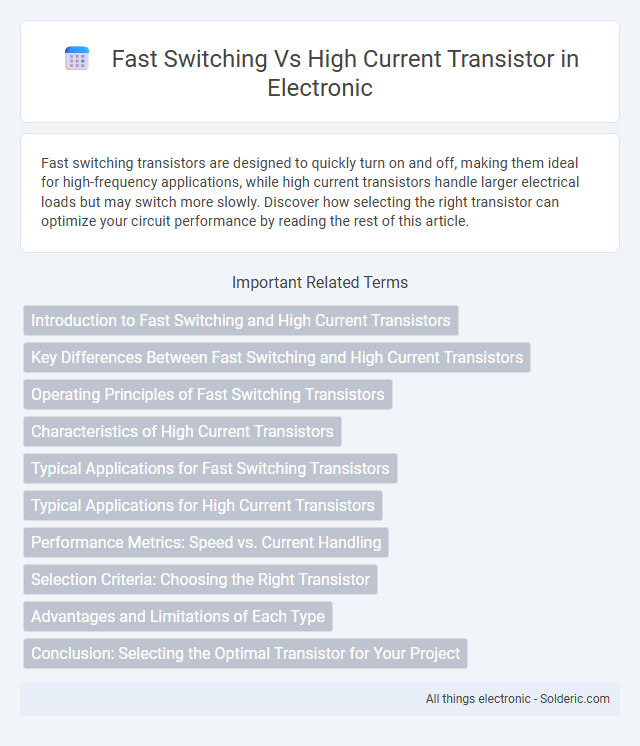Fast switching transistors are designed to quickly turn on and off, making them ideal for high-frequency applications, while high current transistors handle larger electrical loads but may switch more slowly. Discover how selecting the right transistor can optimize your circuit performance by reading the rest of this article.
Comparison Table
| Feature | Fast Switching Transistor | High Current Transistor |
|---|---|---|
| Primary Use | High-speed switching applications | Handling large current loads |
| Switching Speed | Very high (nanoseconds to microseconds) | Moderate to low |
| Current Handling Capability | Low to moderate (up to a few amperes) | High (can exceed tens of amperes) |
| Power Dissipation | Lower due to quick switching | Higher due to large currents |
| Typical Applications | Signal processing, RF circuits, digital switching | Motor drivers, power supplies, amplifiers |
| Example Transistor Types | BJT: 2N2222, MOSFET: 2N7000 | BJT: TIP120, MOSFET: IRF540 |
Introduction to Fast Switching and High Current Transistors
Fast switching transistors excel in applications requiring rapid on/off transitions, enhancing performance in switch-mode power supplies and high-frequency circuits. High current transistors are designed to handle substantial current loads, making them ideal for motor drivers, power amplifiers, and industrial equipment. Your choice depends on whether swift switching speed or robust current-handling capacity is critical for your electronic design.
Key Differences Between Fast Switching and High Current Transistors
Fast switching transistors are engineered for rapid transition times, optimizing performance in high-frequency applications such as signal processing and switching regulators. High current transistors are designed to handle large currents with robust power dissipation capabilities, ideal for power amplification and motor control circuits. The key differences lie in switching speed and current handling capacity, where fast switching transistors prioritize speed over current, while high current transistors emphasize current carrying capability over switching speed.
Operating Principles of Fast Switching Transistors
Fast switching transistors operate by rapidly transitioning between on and off states to minimize switching losses and improve efficiency in high-frequency applications. Their design emphasizes reduced charge storage and carrier lifetimes, enabling swift changes in collector current and voltage. Understanding these principles helps you select the optimal transistor for circuits requiring precise timing and high-speed performance.
Characteristics of High Current Transistors
High current transistors are designed to handle large collector currents, typically ranging from several amperes to tens of amperes, making them suitable for power applications. They exhibit low saturation voltage and robust thermal stability, ensuring efficient operation under high load conditions. Their construction often includes enhanced heat dissipation mechanisms and high gain to maintain reliable switching performance in demanding environments.
Typical Applications for Fast Switching Transistors
Fast switching transistors are commonly employed in applications requiring rapid signal processing and efficient high-frequency operation, such as switch-mode power supplies, pulse width modulation (PWM) controllers, and RF amplifiers. These transistors are ideal for digital circuits, microprocessor interfaces, and communication devices where quick response times minimize signal distortion and improve overall system performance. High current transistors, while capable of handling larger loads, are less suited for fast switching tasks due to slower switching speeds and higher power dissipation.
Typical Applications for High Current Transistors
High current transistors are commonly used in applications requiring substantial power handling, such as motor control, power amplifiers, and voltage regulators. They efficiently manage large current loads in devices like electric vehicles, industrial machines, and power supply units. You can rely on high current transistors for robust performance in circuits demanding durable and heat-resistant switching components.
Performance Metrics: Speed vs. Current Handling
Fast switching transistors excel in speed, with switching times measured in nanoseconds, making them ideal for high-frequency applications and minimizing output signal distortion. High current transistors prioritize current handling capacity, supporting loads of several amperes while maintaining thermal stability and preventing saturation under heavy load conditions. Your choice depends on whether switching speed or current capacity is critical for optimizing overall circuit performance.
Selection Criteria: Choosing the Right Transistor
Selecting the right transistor between fast switching and high current types depends on factors such as switching frequency, current load, and power dissipation requirements. Fast switching transistors excel in applications requiring high-speed signal processing with lower current, while high current transistors are designed to handle larger currents with slower switching speeds. Evaluating the transistor's maximum collector current (Ic), switching time, voltage ratings, and thermal performance is essential to ensure optimal efficiency and reliability in the specific circuit application.
Advantages and Limitations of Each Type
Fast switching transistors excel in applications requiring rapid on/off transitions, offering minimal switching losses and improved efficiency in high-frequency circuits, but they often handle lower current ratings and may suffer from increased thermal stress. High current transistors provide robust performance in heavy-load environments with superior current handling and reliability, yet they typically exhibit slower switching speeds and higher switching losses. Choosing between these types depends on balancing the requirements of switching speed versus current capacity in power management and electronic design.
Conclusion: Selecting the Optimal Transistor for Your Project
Fast switching transistors prioritize rapid on/off transitions ideal for high-frequency applications, while high current transistors are designed to handle larger loads with robust thermal management. Selecting the optimal transistor depends on balancing switching speed requirements against current capacity and power dissipation needs. For projects demanding quick signal processing, fast switching transistors enhance performance, whereas high current transistors ensure reliability in power-intensive circuits.
Fast switching vs High current transistor Infographic

 solderic.com
solderic.com